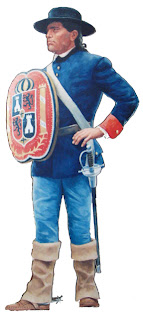Please Join me in welcoming our second Guest Writer, Craig Schmidt
This a few helpful research hints for you gentlemen that are just starting out. The hardest thing to get, surprisingly enough, is where to start. Who are you? Where are you from? What time period? What profession? All these things will dictate your dress, and accoutrements.
For
example, my area of “expertise” is Colonial and Republic era
Texas (c. 1821 – 1845). I usually portray a ranger or Republic era
dragoon. What makes this a challenge is that the history is so
intertwined with legend and myth that finding the truth is a hard
thing. But the basics are fairly easy. Fashion of the time is well
documented and easy enough to reproduce. But a few notes of caution.
Be
sure you know the usage of terms. Many word definitions today do not
reflect what they mean it the late 18th
or 19th
centuries. For example, my first flintlock was a Jaeger rifle. I
had seen where a list of stores requested by the Consultation for the
People’s Army included Yager (Jaeger) rifles. So I assumed that
this was the short German style rifle used by German Jaegers
(Scouts/light infantry, literally hunters.). Later in my research I
found that this reference was most likely in regard to the M1803
Harper’s Ferry Rifle, or even the M1817 Common Rifle. Just as a
reference to a “biscuit” is not necessarily the light fluffy
breakfast food, but depending on the usage could be hardtack (aka sea
biscuit).
Also,
spelling can be tricky. Especially in firsthand accounts (Journals,
diaries and the such.) spelling is often phonetic, and sometimes the
same word is spelled differently in the same sentence. Names also
suffer from this same affliction. So what you think might be
references to two different people, are, in fact, referencing one
person.
The
other maddening thing about using firsthand accounts is that usually
there is only detail about the unusual. The common place is just
that and there is no need to detail the common as everyone knows it.
Let’s
consider sources for a bit. It’s tempting to use the internet
exclusively. The internet is convenient, but there’s no
substitution for good old fashioned book work. My personal library
for specifically Texas pre-state history has a rough total of between
twenty and thirty volumes. And it continues to grow.
Whenever
possible, firsthand accounts are the best material for really getting
a view on the attitudes of the time. As well as an insight into
speech patterns
It’s
not necessary to buy books like a wild thing. The public library is
a perfectly fine resource. I just like to be able to access my
references whenever I want. Amazon, Alibris and Powell’s are my
friends… And don’t forget periodicals!
Another
word on books/articles etc., always check the bibliography. It’s a
treasure-trove of new sources and could possibly lead to a nugget
that could easily be overlooked. Which explains why my bookshelves
are overflowing currently…
Somewhere
along the line in your research you’ll run across some really neat
accoutrement, or article of clothing that you really
like. But you need to be able to justify why your persona would have
such an item, or article of clothing. Just because something exists
at the time period doesn’t necessarily mean it was available to you
where you’re located.
Using
me as an example, as a ranger in Colonial/Republic Texas I probably
would not have leggings in the style of the northeastern tribes (A
recent immigrant might… But I usually portray a person that has
been in country for a while.). It is more likely that I would be
wearing Mexican style botas. See the picture of the Soldado de cuera
below.
 |
| Photo courtesy of Armas y armaduras en Espania |
Likewise
a large clip-point Bowie, while I personally love them, wouldn’t be
quite appropriate for an early Texian Anglo. I use an eight inch
“Longhunter” knife, or a ten inch Spanish/Mexican Belduque.
Top
to Bottom: Mid to late 19th
Century Bowie, Spanish/Mexican Belduque, “Longhunter” Knife
(Photo: Craig Schmidt, C. Schmidt Collection)
While
all three are similar, the correct blade can make the difference
between an O.K. impression and a stunning impression.
I
hope that this helps somewhat. There are many other pitfalls, and
cautions, but you need to take the first step. Make your decisions
on your era, and profession, and go from there.
Happy
hunting, um… researching!


No comments:
Post a Comment